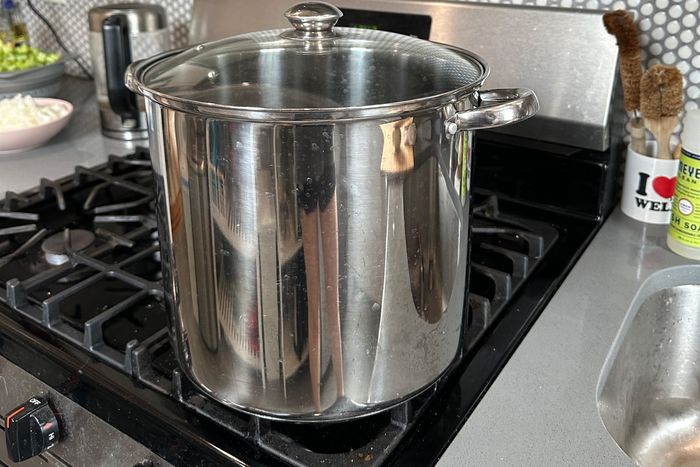
We are currently at the height of what many refer to as “soup season.” Personally, I believe soup should be enjoyed throughout the year, so I don’t subscribe to such limitations. For me, the colder months have come to instead represent Gilded Age season. In 2022, the Max series appeared when I needed it most. It had low-stakes, smooth-brained plotlines; gorgeous costuming; and Christine Baranski dropping delicious zingers awakening me from the fugue state I was in and easing me gently through the lowest point of my seasonal depression. Last year, as if the creators knew I was really going through it, the show returned, this time easing me into the start of the winter and offering me an absolutely gripping soup-centric narrative in episode five. Believe me when I say I was beaming with joy when Bertha Russell’s Big Duke Dinner (BDD) went off without a hitch — and without any spilled soup.
Much like the first two seasons of The Gilded Age, soup has always been there for me. In college, learning how to make favorites like egg-drop soup and my own dairy-free version of cream of mushroom helped me feel like a real adult. The first year I lived in New York, my obsession with trying bowl after bowl of ramen helped me get to know the city and offered creamy, springy comfort when I was lonely. When I went through a heartbreak so intense I couldn’t get beyond a few bites of food without becoming nauseous, a warming garlic-ginger broth provided much-needed sustenance. And now, thanks to Becky Libourel Diamond and her book The Gilded Age Cookbook, I have been granted the opportunity to fill the Gilded Age hole in my heart with the next best thing: Gilded Age soup.
As a soup devotee, I’ve tried a great many soups. But I had never tried what Diamond dubs a “potage purée,” which, according to the book, would’ve been found on a train dinner menu in a Pullman Dining Car. Since The Gilded Age’s George Russell is famously a railroad tycoon (that’s actually his side hustle; his main job is being a wife guy), I like to think his wife, Bertha, would serve an iconic railroad recipe on her menu as a nod to the industry. Also, the soup consumed at the BDD did look like it could’ve been a purée; I didn’t spot a single chunk as it was being swiftly poured into Bertha’s best china. So I decided to blast the Gilded Age soundtrack and spend a day cosplaying as a scullery maid, making the Gilded Age soup for myself (and my colleagues).
The recipe itself is pretty simple, involving only three steps and 11 ingredients. To start, I had a lot of chopping to do; it calls for chopped leeks, chopped carrots, chopped white onions, and chopped celery. I quickly decided to double the recipe, both because I had too much produce and because I wanted to use my most gigantic pot to match the one they use on the show (although mine is not made of gorgeous copper). Once I had chopped everything up, I had to grind up some cloves with my fancy new spice grinder. That’s when I really started to get into character, because it took more than ten minutes to grind up a quarter of a teaspoon, although I think this may have had something to do with my own user error in the grind settings. Either way, as I ratcheted the handle back and forth, I started to envision the family I could be supporting back in Ireland. Finally, it was time to heat the butter over medium-high and add the veggies into the pot to sauté. The recipe says to do this for “two-to-three minutes until just starting to brown,” but I sautéed them for significantly longer because the veggies showed minimal signs of browning.


The next step was to add lentils, along with the cloves and the rest of the seasoning — salt, white pepper, dried thyme — and vegetable broth, which I’m just now realizing I forgot to double. Oops. Anyway, I brought it to a boil, took it down to low heat, covered it, and let it simmer for two hours. Still in character, I used some of this time to wash dishes and clean my kitchen … real scullery-maid hours.


The final and most puzzling step was to purée the soup. This was a breeze for me because I could use an immersion blender. But it was not so simple for kitchen dwellers of the gilded age! A colleague offered up the possibility that they’d use a food mill, a precursor to the blender. That can’t be right, though, because those were invented in the 1920s. I can imagine mashing up some of these veggies, but leeks? Even onions wouldn’t mash particularly well. The only possibility I could find online was that they’d use a sieve, which I do think would work but sounds extremely tedious. I certainly can’t imagine it being done in a tight railroad kitchen. I reached out to Diamond to see if she had any answers, and she confirmed my theory, writing back, “This recipe (and any other purées during the gilded age) would have just ended up as a chunkier version than we have today as they would have been mashed by hand.” By hand! My word. She also shared the Pierre Blot recipe hers is based on, in which the onion and leek would have been removed prior to mashing. Mystery solved, and gratitude for modern technology solidified. Behold:
As you can see, it’s extremely thick, which it turns out is because I doubled every ingredient except for the broth. Since I was pretty hungry at that point, I wasn’t really bothered by the texture; I was craving something hearty. I poured my soup and sat down, transforming myself into an esteemed society guest, and delicately slurped up a spoonful. The first flavor to hit me immediately was the lentils, followed by a surprisingly spicy, slightly smoky aftertaste that I attribute to the white pepper and the cloves. I could imagine adding in a protein, like baked tofu, for something reminiscent in texture, if not flavor, to a butter chicken curry. All in all, I was pleased and comforted. It was rainy and cold outside, and the recent snow had yet to melt, but all I felt was the warmth that only soup and robber baron amassed wealth could provide.
The next day I loaded the soup into a large Tupperware container and brought it to work for some colleagues to sample. Cut deputy style editor Joanna Nikas liked it and said she was hungry enough to eat a full bowl, while Cut features editor Catherine Thompson called it “a soup with heft; a thicc Victorian boi, if you will,” and said, “The cloves give it a really nice warmth that’s not overpowering.”
Dominique Pariso and Liza Corsillo of the Strategist offered more lukewarm reviews. “It’s bringing me back to the co-op I lived in in college where we mostly ate variations of lentil mush. Immediate sense memory,” said Dominique. “It’s not the grandeur that I associate with the gilded age, more the ‘We need to eat for 25 cents per person’ vibe.” Liza added that the flavor profile was lentil-forward and that she was getting a smoky tomato taste. Ultimately, she said, it was overly blended; she prefers a chunkier soup.
Finally, it was sampled by certified-soup-hater Danielle Cohen, a staff writer for the Cut. Sadly, this “potatoey” purée did not convert her to the soupy side of life, but she did concede that it would make for a good panini dip or even a rice bowl topping. “The texture and color remind me of refried beans,” she added. “It does taste like what Americans were eating in the 19th century … I believe they ate food like this.”
Considering that the textural issues were entirely my error and not the fault of the recipe, I’m going to call this a success, although I’m pretty sure I’m about to lose my job as a scullery maid for sabotaging Bertha’s soup. Ultimately, this is a great and relatively easy recipe for soup season, and I’ll be making another big batch, this time with the correct broth ratio, for my watch party when season three comes around.






